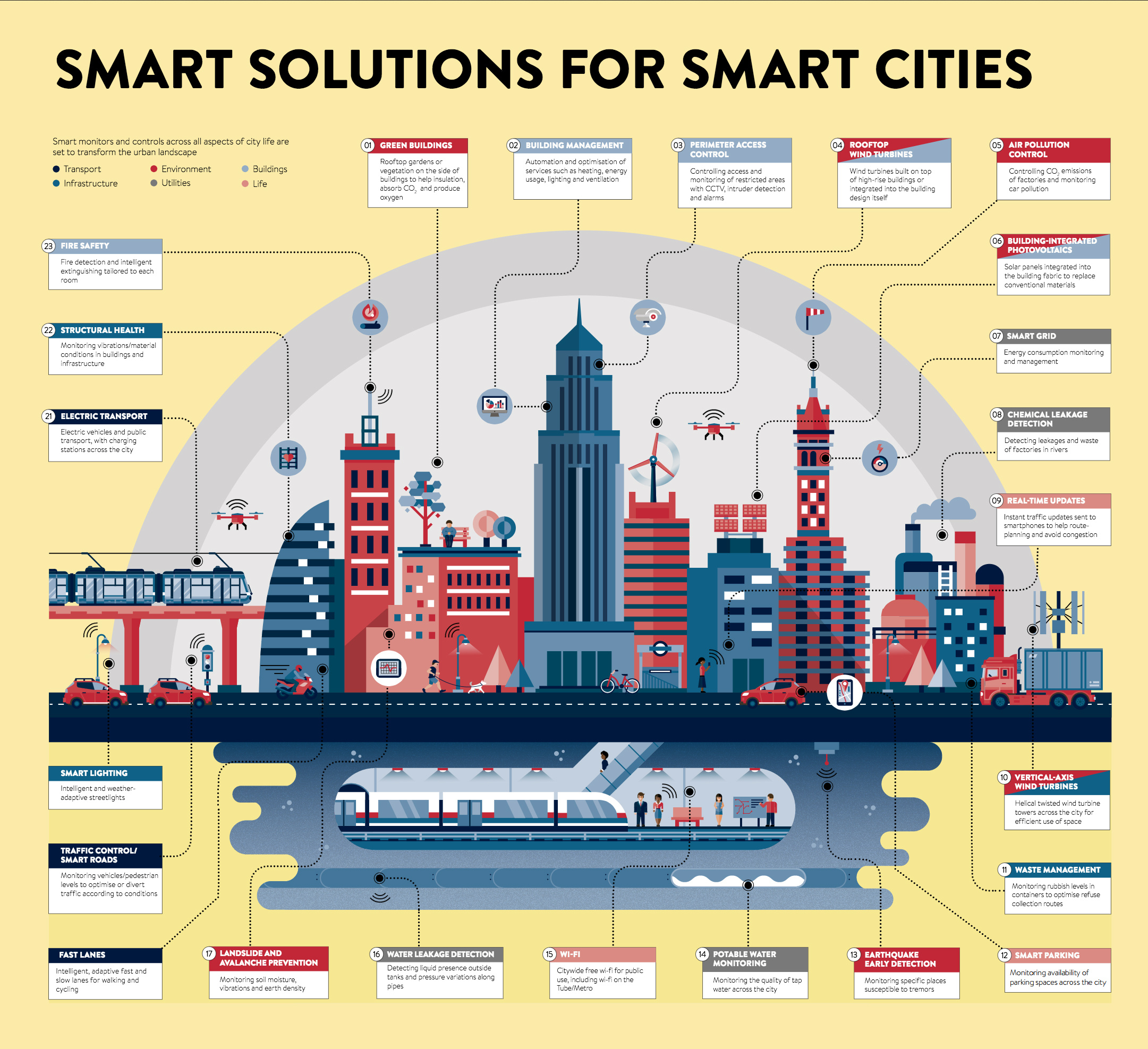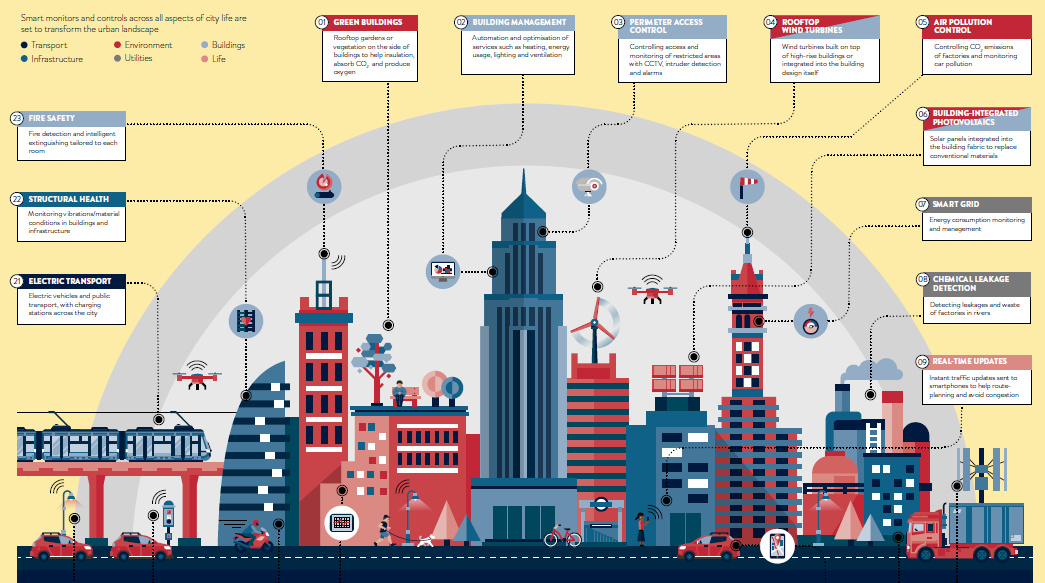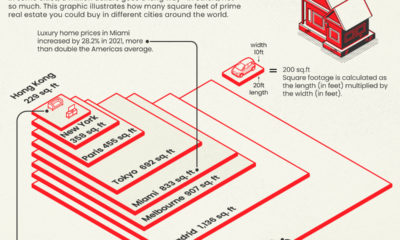The Anatomy of a Smart City
There is no doubt that the city will be the defining feature of human geography for the 21st century. Globally, there are 1.3 million people moving to cities each week – and by 2040, a staggering 65% of the world’s population will live in cities. At the same time, the 600 biggest urban areas already account for 60% of global GDP, and this will only rise higher as cities become larger and more prosperous. In fact, experts estimate that up to 80% of future economic growth in developing regions will occur in cities alone.
The Smart City: A Necessary Step
As cities become an even more important driver of the global economy and wealth, it’s becoming crucial to ensure that they are optimized to maximize efficiency and sustainability, while enhancing the quality of life in each urban conglomeration. Today’s infographic from Postscapes helps define the need for smart cities, and it also gives great examples of how technology can be applied in urban settings to facilitate cities that work better for their citizens.
Features of Tomorrow’s Cities
Smart cities will use low power sensors, wireless networks, and mobile-based applications to measure and optimize everything within cities. Here are just some examples: (click below image to open full-size version)
Smart city solutions will fall into six broad categories, transforming the urban landscape:
- Infrastructure Smart lighting is one of the most important solutions that will be implemented in citywide infrastructure. While smart lighting sounds trivial at first glance, it’s worth noting that lighting alone consumes a whopping 19% of the world’s total electricity.
- Buildings Heating, energy usage, lighting, and ventilation will be managed and optimized by technology. Solar panels will be integrated into building design, replacing traditional materials. Fire detection and extinguishing is tailored to individual rooms.
- Utilities Smart grids (used for energy consumption monitoring and management), water leakage detection, and water potability monitoring are just some smart city aspects on the utilities side.
- Transport Intelligent, adaptive fast lanes and slow lanes (cycling, walking) will be implemented, while charging stations through the city will power EVs.
- Environment Air pollution control, renewable energy, and waste management solutions will make for greener cities. Rooftop gardens or side vegetation will be integrated into building designs, to help with insulation, provide oxygen, and absorb CO2.
- Life There will be citywide Wi-Fi for public use, while real-time updates will provide citizens information on traffic congestion, parking spaces, and other city amenities.
The Effect?
Cisco estimates that smarter cities will have impressive increases in efficiency: using many of the above concepts, cities can improve energy efficiency by 30% in 20 years. Simultaneously, it’s estimated that the broad market for smart cities products and services will be worth $2.57 trillion by 2025, growing at a clip of 18.4% per year on average. on But fast forward to the end of last week, and SVB was shuttered by regulators after a panic-induced bank run. So, how exactly did this happen? We dig in below.
Road to a Bank Run
SVB and its customers generally thrived during the low interest rate era, but as rates rose, SVB found itself more exposed to risk than a typical bank. Even so, at the end of 2022, the bank’s balance sheet showed no cause for alarm.
As well, the bank was viewed positively in a number of places. Most Wall Street analyst ratings were overwhelmingly positive on the bank’s stock, and Forbes had just added the bank to its Financial All-Stars list. Outward signs of trouble emerged on Wednesday, March 8th, when SVB surprised investors with news that the bank needed to raise more than $2 billion to shore up its balance sheet. The reaction from prominent venture capitalists was not positive, with Coatue Management, Union Square Ventures, and Peter Thiel’s Founders Fund moving to limit exposure to the 40-year-old bank. The influence of these firms is believed to have added fuel to the fire, and a bank run ensued. Also influencing decision making was the fact that SVB had the highest percentage of uninsured domestic deposits of all big banks. These totaled nearly $152 billion, or about 97% of all deposits. By the end of the day, customers had tried to withdraw $42 billion in deposits.
What Triggered the SVB Collapse?
While the collapse of SVB took place over the course of 44 hours, its roots trace back to the early pandemic years. In 2021, U.S. venture capital-backed companies raised a record $330 billion—double the amount seen in 2020. At the time, interest rates were at rock-bottom levels to help buoy the economy. Matt Levine sums up the situation well: “When interest rates are low everywhere, a dollar in 20 years is about as good as a dollar today, so a startup whose business model is “we will lose money for a decade building artificial intelligence, and then rake in lots of money in the far future” sounds pretty good. When interest rates are higher, a dollar today is better than a dollar tomorrow, so investors want cash flows. When interest rates were low for a long time, and suddenly become high, all the money that was rushing to your customers is suddenly cut off.” Source: Pitchbook Why is this important? During this time, SVB received billions of dollars from these venture-backed clients. In one year alone, their deposits increased 100%. They took these funds and invested them in longer-term bonds. As a result, this created a dangerous trap as the company expected rates would remain low. During this time, SVB invested in bonds at the top of the market. As interest rates rose higher and bond prices declined, SVB started taking major losses on their long-term bond holdings.
Losses Fueling a Liquidity Crunch
When SVB reported its fourth quarter results in early 2023, Moody’s Investor Service, a credit rating agency took notice. In early March, it said that SVB was at high risk for a downgrade due to its significant unrealized losses. In response, SVB looked to sell $2 billion of its investments at a loss to help boost liquidity for its struggling balance sheet. Soon, more hedge funds and venture investors realized SVB could be on thin ice. Depositors withdrew funds in droves, spurring a liquidity squeeze and prompting California regulators and the FDIC to step in and shut down the bank.
What Happens Now?
While much of SVB’s activity was focused on the tech sector, the bank’s shocking collapse has rattled a financial sector that is already on edge.
The four biggest U.S. banks lost a combined $52 billion the day before the SVB collapse. On Friday, other banking stocks saw double-digit drops, including Signature Bank (-23%), First Republic (-15%), and Silvergate Capital (-11%).
Source: Morningstar Direct. *Represents March 9 data, trading halted on March 10.
When the dust settles, it’s hard to predict the ripple effects that will emerge from this dramatic event. For investors, the Secretary of the Treasury Janet Yellen announced confidence in the banking system remaining resilient, noting that regulators have the proper tools in response to the issue.
But others have seen trouble brewing as far back as 2020 (or earlier) when commercial banking assets were skyrocketing and banks were buying bonds when rates were low.


















